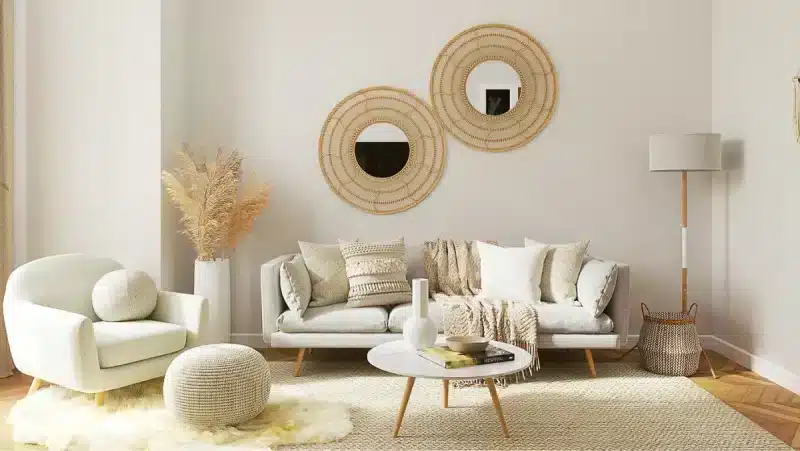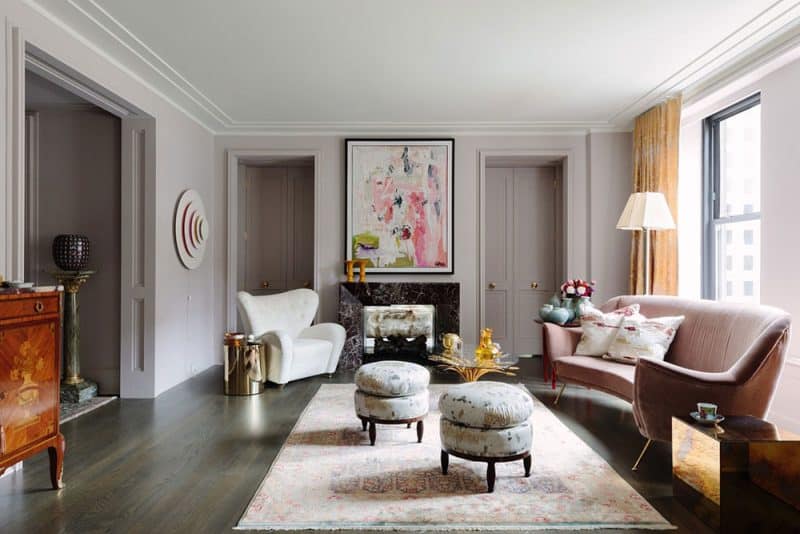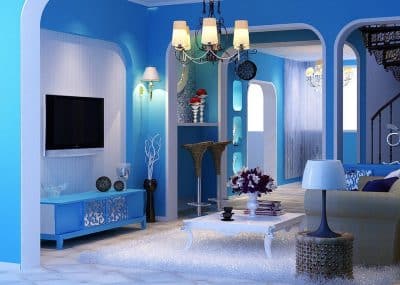
Art Deco, a style symbolizing luxury and magnificence from the past, has made a strong comeback in modern interior design. This decorative movement, which flourished in the 1920s and 1930s, is characterized by big, bold geometric patterns, rich colors, and opulent ornamentation. Today, Art Deco combines vintage glamour with contemporary architecture in modern homes, creating spaces that are both luxurious and welcoming. This renewed interest not only evokes the grandeur of the past but also injects dynamism and elegance into today’s interiors. The following article explores the history, characteristics, and ways to seamlessly blend Art Deco elements into modern design, resulting in spaces that are both classic and sophisticated.
The Historical Influence of Art Deco
Art Deco emerged during the 1920s, a period marked by rapid industrialization, economic prosperity, and cultural transformation. Designers developed the Art Deco style as a response to the ornate and intricate designs of Art Nouveau, offering a more streamlined, geometric approach that reflected the modern age. Technological advancements and the optimism of the post-World War I era significantly influenced the style, leading to the incorporation of sleek lines, symmetry, and a sense of orderliness that symbolized progress and modernity. Beyond interior design, its influence extended to architecture, fashion, art, and even automotive design, making it one of the most significant movements of the 20th century.
The Evolution of Art Deco Over Time
Art Deco has evolved significantly since its inception, adapting to changing tastes and technological advancements. The original style was synonymous with luxury and opulence, yet later interpretations of Art Deco often embraced more minimalist and functional aspects. The influence of Art Deco appears in various design movements throughout the 20th century, from Mid-Century Modern to contemporary minimalism. This evolution underscores Art Deco’s enduring appeal and its capacity to inspire new generations of designers. As the style continues to evolve, it remains a testament to the creativity and innovation of the early 20th century.
Iconic Art Deco Architecture
Art Deco’s influence shines brightly in architecture, with iconic structures that continue to captivate today. The Chrysler Building in New York, with its gleaming spire and intricate metalwork, epitomizes Art Deco’s grandeur. Similarly, the Palais de Chaillot in Paris highlights the style’s emphasis on symmetry, geometric forms, and luxurious materials. Not only do these buildings define skylines, but they also embody the spirit of an era that celebrated modernity, luxury, and elegance. Designers skillfully used decorative motifs, such as sunbursts and zigzags, to combine functionality with aesthetic appeal, creating timeless landmarks.

Key Characteristics of Art Deco Style
Geometric Symmetry and Streamlined Shapes
Art Deco interior design is instantly recognizable by its emphasis on geometric symmetry and streamlined shapes. The style features sharp angles, bold lines, and repetitive patterns, often seen in zigzag, chevron, and sunburst motifs. These elements serve as both decorative and functional, creating a sense of order and structure within a space. The geometry of Art Deco extends to furniture, lighting, and even room layouts, where angular lines and precise forms dominate. This focus on symmetry and streamlined shapes reflects the era’s fascination with the machine age and the desire to create spaces that were both functional and aesthetically pleasing.
Bold Colors and Luxurious Combinations
Color plays a central role in Art Deco interior design, with a palette that includes vibrant hues such as yellow, red, green, and blue, alongside deep pinks, blacks, and metallics like chrome and silver. Designers often combined these colors with luxurious materials like lacquer, mirrored glass, chrome, and exotic woods to create a look that is both opulent and modern. The use of bold colors and rich materials reflected the optimism and excitement of the time, capturing the spirit of an era that was both glamorous and forward-looking. In modern interiors, these vibrant colors can create a striking contrast against more subdued backgrounds, adding a touch of Art Deco flair.
Rich Materials and Elegant Detailing
Art Deco’s use of rich materials and elegant detailing, often inspired by ancient cultures such as Egyptian, African, and Mayan art, sets it apart. These influences appear in the streamlined shapes, intricate patterns, and luxurious finishes that characterize the style. Designers frequently incorporated materials like marble, ebony, ivory, and mother-of-pearl to create an air of sophistication and luxury. Details such as intricate inlays, ornate metalwork, or luxurious fabrics add depth and texture to a space, contributing to a sense of timeless elegance that remains relevant today.
Balancing Art Deco with Modern Elements
Balancing Art Deco with modern elements is key to creating a harmonious and sophisticated interior. Contemporary designers embrace the trend of integrating Art Deco elements into modern interiors, merging these elements with modern design principles to create spaces that are both unique and stylish. Often, designers use geometric patterns and straight lines, key features of Art Deco, but in a smoother and more minimalistic way. This approach might involve using Art Deco-inspired details as focal points—such as an ornate mirror or a statement piece of furniture—within a more subdued, modern setting.
Today’s adaptations of Art Deco interior design often focus on functionality, integrating the style’s signature opulence in a way that meets the needs of modern spaces. For example, designers may tone down the dramatic color palette typical of Art Deco to complement the neutral tones popular in contemporary interiors. This balance between bold Art Deco elements and modern simplicity allows for a sophisticated and timeless look that appeals to contemporary tastes. The goal is to achieve a balance where the intricate details of Art Deco accessories enhance simple, modern furniture, resulting in a space that feels both timeless and stylish.
Art Deco in Furniture and Decor
A Blend of Style and Symmetry
Art Deco furniture is easily recognizable by its straight lines, geometric forms, and often high-gloss finishes. Key pieces include luxuriously upholstered armchairs with streamlined shapes, lacquered wood cabinets with bold symmetry, and inlaid coffee tables that serve as functional works of art. These furniture items often combine straight and curved lines, capturing the essence of Art Deco’s opulence while embracing modern trends. Choosing these iconic pieces helps to anchor an Art Deco theme in a room, making it clear that the space is part of this timeless aesthetic.
Decorative Accents in Art Deco Design
Decorative accents play a crucial role in achieving an Art Deco-inspired interior. Sunburst or angular, chrome-framed mirrors are quintessential Art Deco items that instantly add glamour to any room. Similarly, geometrically shaped chandeliers or lamps with glass and chrome elements reflect the era’s love of industrial materials and sleek design. Additionally, incorporating artistic wall elements with striking graphics or sculptures enhances the Art Deco vibe, making the space feel like a modern gallery of Art Deco artifacts.
Art Deco Lighting: Elegance and Functionality
Lighting plays an essential role in any Art Deco interior design, combining elegance with functionality. Art Deco lighting fixtures are often bold and sculptural, featuring geometric shapes, polished metals, and frosted glass. Chandeliers, wall sconces, and table lamps from the Art Deco era often have a sense of grandeur, with intricate designs that draw the eye. In a modern context, these lighting elements can create focal points in a room, highlighting architectural features or adding a layer of sophistication to the overall design. The right lighting not only enhances the aesthetic of a space but also contributes to the luxurious atmosphere central to Art Deco interior design.
Art Deco in Textiles and Patterns
Textiles and patterns play a crucial role in bringing Art Deco into the modern home. The style is known for its use of luxurious fabrics such as velvet, silk, and brocade, often featuring bold geometric patterns or intricate motifs. These textiles can be used for upholstery, curtains, and cushions, adding a touch of elegance and richness to any space. In terms of patterns, Art Deco favors repetitive, symmetrical designs such as chevrons, zigzags, and fan shapes. Designers incorporate these patterns into modern interiors through wallpaper, rugs, or even art pieces, providing a visual link to the past while maintaining a contemporary aesthetic.
Mixing Art Deco with Other Styles
Art Deco’s boldness and elegance make it a perfect candidate for mixing with other design styles, creating interiors that are eclectic yet cohesive. For instance, Art Deco can be combined with modern minimalism to create spaces that are both striking and serene. The key is to balance the opulence of Art Deco with the simplicity of modern design, using color, texture, and form to create a harmonious blend. For example, a monochromatic room can be enlivened with a few bold Art Deco pieces, such as a sunburst mirror or a geometric-patterned rug. This approach allows homeowners to enjoy the best of both worlds, merging the timeless appeal of Art Deco with the clean lines and functionality of contemporary design.
Art Deco: A Global Influence
Art Deco, though originating in Europe and the United States, quickly spread across the globe, adapting to local cultures and aesthetics. In Asia, for instance, Art Deco architecture and design often incorporated traditional motifs and materials, creating a unique fusion of Eastern and Western styles. In Latin America, particularly in cities like Havana and Buenos Aires, Art Deco left a lasting impact on urban landscapes, with buildings that reflect both the glamour of the era and the cultural richness of the region. This global influence underscores Art Deco’s versatility and its ability to transcend cultural boundaries, making it a truly international style.
Conclusion
The Art Deco interior design revival in modern homes is more than just a trend—it celebrates an era that was both bold and luxurious, with a style that continues to stand out. Understanding its key principles—geometric patterns, luxurious materials, and the ability to create spaces that are simultaneously timeless and contemporary—makes Art Deco interiors so unique. Whether through the choice of furnishings, color palettes, or subtle decorative details, Art Deco interior design offers numerous ways to enrich and personalize contemporary spaces, blending the best of the past with the functionality and simplicity of the present. As Art Deco continues to evolve and influence modern design, it remains a testament to the enduring appeal of elegance and luxury in interior design.









